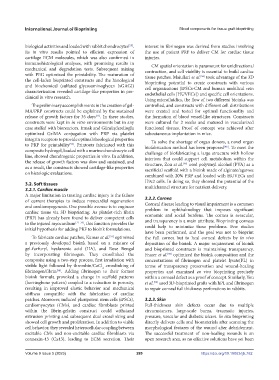Page 297 - IJB-9-5
P. 297
International Journal of Bioprinting Blood components for tissue graft bioprinting
biological activities and loaded with rabbit chondrocytes . interest in fibrinogen was derived from studies involving
[53]
Its in vitro results pointed to efficient expression of the use of patient PRF to deliver CM for cardiac tissue
cartilage ECM molecules, which was also confirmed in injuries.
immunohistological analyses, with promising results in CM spatial orientation is paramount for unidirectional
mechanical and degradation tests. Subsequent mixing contraction, and cell viability is essential to build cardiac
with PEG optimized the printability. The maturation of tissue patches. Maiullari et al. took advantage of the 3D
[56]
the cell-laden bioprinted constructs and the histological bioprinting potential to create constructs with various
and biochemical (sulfated glycosaminoglycan [sGAG]) cell organizations (IPSCs-CM and human umbilical vein
characterization revealed cartilage-like properties in pre- endothelial cells [HUVECs]) and specific cell orientations.
clinical in vitro research. Using microfluidics, the flow of two different bioinks was
The preliminary accomplishments in the creation of gel- controlled, and constructs with different cell distributions
MA/PRP constructs could be explained by the sustained were created and tested for optimal functionality and
release of growth factors for 35 days . In these studies, the formation of blood vessel-like structures. Constructs
[52]
constructs were kept in in vitro environments but in any were cultured for 2 weeks and matured in vascularized
case staffed with bioreactors. Irmak and Gümüşderelioglu functional tissues. Proof of concept was achieved after
optimized GelMA conjugation with PRP via platelet subcutaneous implantation in mice.
integrin receptors to provide optimal rheological properties To solve the shortage of organ donors, a novel organ
to PRP for printability . Printouts fabricated with this biofabrication method has been proposed . To meet the
[52]
[46]
composite hydrogel, loaded with a murine chondrocyte cell challenge of biofabricating a large structure with hollow
line, showed chondrogenic properties in vitro. In addition, interiors that could support cell metabolism within the
the release of growth factors was slow and sustained, and structure, Zou et al. used polyvinyl alcohol (PVA) as a
[46]
as a result, the constructs showed cartilage-like properties sacrificial scaffold with a bioink made of alginate/agarose
on histologic evaluations.
combined with 20% PRP and loaded with HUVECs and
3.2. Soft tissues H9c2 cells. In doing so, they showed the potential of the
3.2.1. Cardiac muscle multichannel structure for nutrient delivery.
A major limitation in treating cardiac injury is the failure
of current therapies to induce myocardial regeneration 3.2.2. Cornea
and cardiomyogenesis. One possible avenue is to engineer Corneal disease leading to visual impairment is a common
cardiac tissue via 3D bioprinting. As platelet-rich fibrin problem in ophthalmology that imposes significant
(PRF) has already been found to deliver competent cells economic and social burdens. The cornea is avascular,
to the injured myocardium [77–79] , this function provides the and transparency is a main attribute. Bioprinting corneas
initial hypothesis for adding PRF to bioink formulations. could help to minimize these problems. Few studies
have been performed, and the goal was not to bioprint
To fabricate cardiac patches, Kumar et al. optimized the full cornea but to heal corneal defects by in vivo
[54]
a previously developed bioink based on a mixture of deposition of the bioink. A major requirement of bioink
gel-furfuryl, hyaluronic acid (HA), and Rose Bengal and bioprinted constructs is maintaining transparency.
by incorporating fibrinogen. They crosslinked the Frazer et al. optimized the bioink composition and the
[58]
composite using a two-step process, first irradiation with concentrations of fibrinogen and platelet lysate(PL) in
visible light followed by thrombin/CaCl crosslinking of terms of transparency preservation and wound-healing
2
fibrinogen/fibrin . Adding fibrinogen to their former properties and examined ex vivo bioprinting precisely
[54]
bioink formula provoked a change in scaffold patterns within a corneal defect as a proof of concept. Similarly, You
(herringbone pattern) coupled to a reduction in porosity, et al. used 3D-bioprinted grafts with hPL and fibrinogen
[59]
resulting in improved elastic behavior and mechanical to repair corneal full thickness perforations in rabbits.
stiffness compatible with the fabrication of cardiac
patches. Moreover, induced pluripotent stem cells (iPSCs), 3.2.3. Skin
cardiomyocytes (CMs), and cardiac fibroblasts printed Full-thickness skin defects occur due to multiple
within the fibrin-gelatin construct could withstand circumstances, large-scale burns, traumatic injuries,
extrusion printing and subsequent dual crosslinking and pressure, vascular and diabetic ulcers. In situ bioprinting
showed cell growth and proliferation. In addition to viable directly delivers cells and biomaterials after scanning the
cell behavior, they revealed heterocellular coupling between morphological features of the wound after debridement.
excitable CMs and non-excitable cardiac fibroblasts via The successful treatment of non-healing wounds is an
connexin-43 (Cx43), leading to ECM secretion. Their open research area, as no effective solutions have yet been
Volume 9 Issue 5 (2023) 289 https://doi.org/10.18063/ijb.762

